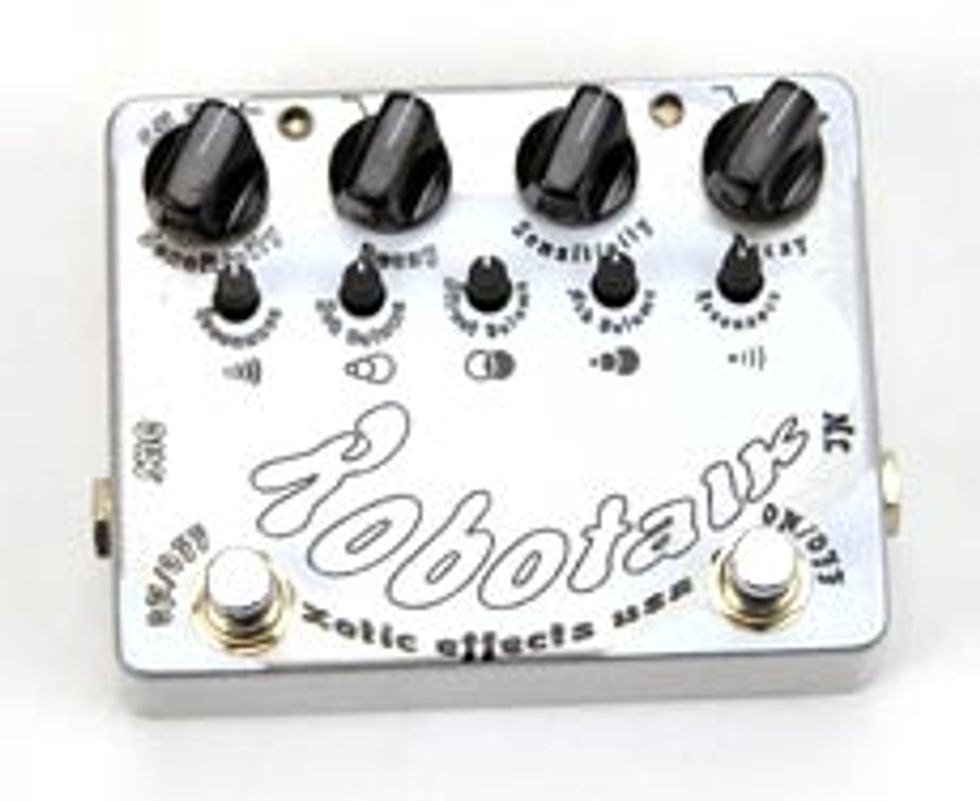Xotic Effects' Robotalk 2 is a pro-grade envelope filter.
 | |
| Download Example 1 Strumming | |
| Download Example 2 Picking | |
| The Robotalk 2 envelope filter played through a humbucker equipped guitar in the bridge position (SD pickups). Moves from uneffected signal to Channel A engaged (Sensitivity at 12:30; Decay at 2:00), then to both Channel A and Channel B engaged (Sensitivity at 12:30, Decay at 8:30), and finally to Channel B alone. Recorded with a modded Epiphone Valve Jr. head and a Eminence 12" Red Fang speaker, through a Shure SM57 and ProSonus Audiobox interface into Cubase. No EQ adjustments; minor compression on the track. | |
Debuting at this year’s NAMM show, the Robotalk 2 proves that Xotic has been listening to players, adding in features they want and cutting the rest. The Robotalk 2 refines and focuses the scope of the original version, adding another envelope filter channel and dispensing with the random arpeggiator function. Each channel features Sensitivity and Decay knobs located at the top of the box, along with Channel Volume and Resonance mini-knobs situated underneath. A Direct Volume mini-knob is shared by the two channels, and essentially functions as a Mix control (more on this in a moment).
Versatility is the name of the game here. While the Robotalk 2 doesn’t pack in any real surprises, envelope filter fans of all stripes should find something to like. For starters, the two channels are each distinctively voiced, giving players two different jumping-off points; the A Channel is more midrangey and a bit hotter, making it suitable for lead lines and notes higher up on the neck, while the B Channel dials down the midrange and the gain for chord work. If you’re still not digging the sound, four internal dip-switches allow you to lower the envelope frequency—I actually preferred this over the stock settings, as the Robotalk 2 became more round and vocal, and less nasal, but the point is that Xotic was wise enough to let you decide what works for you.
On the topside, the Sensitivity and Resonance controls work as you would expect, but the Decay and Direct Volume controls provide for some extended tone-shaping. The Decay knob in particular has an impressive range to it, allowing you to move from deep textures to sharp, percussive snaps. In fact, some of the coolest sounds in the Robotalk 2 actually came from setting the channels with opposing Decay settings and engaging them both at the same time; you get both percussive funkiness and slower wah-tones simultaneously. And while the true bypass Robotalk 2 resists imprinting itself upon your tone too heavily, the Direct Volume control allows you to tweak your dry/wet signal balance, so you can either go all filter or keep more of your instrument’s attack, so it isn’t washed away altogether.
To be honest, the only real complaints I had with the Robotalk 2 were on the surface level. While the pedal is built like a tank, the paint scheme has the dual distinction of being a bit bland and making the control labels difficult to read from a distance. And it could just be my Western left-to-right bias, but the fact that Channel A appears on the right side and Channel B on the left seems somewhat counter-intuitive. But that’s really personal preference and backseat design—if you could care less about being able to read your control labels, then the Robotalk 2 will serve you just fine.
The Final Mojo
Xotic’s Robotalk 2 will likely be a revelation for any player who has been searching for the perfect envelope filter—it can do subtle, it can do intense, and everything in-between without sacrificing nuance or control. At an MSRP of $280, the Robotalk 2 may look a little expensive in comparison to other popular filters, but if you’re tired of buying and selling pedal after pedal, this could be the one that ends your search.
Buy if...
you're looking for a pro-grade filter pedal that will cover all of your basses.
Skip if...
the envelope filter makes only a brief appearance on your set list.
Rating...
MSRP $280 - Xotic Effects - xotic.us |
From Your Site Articles

